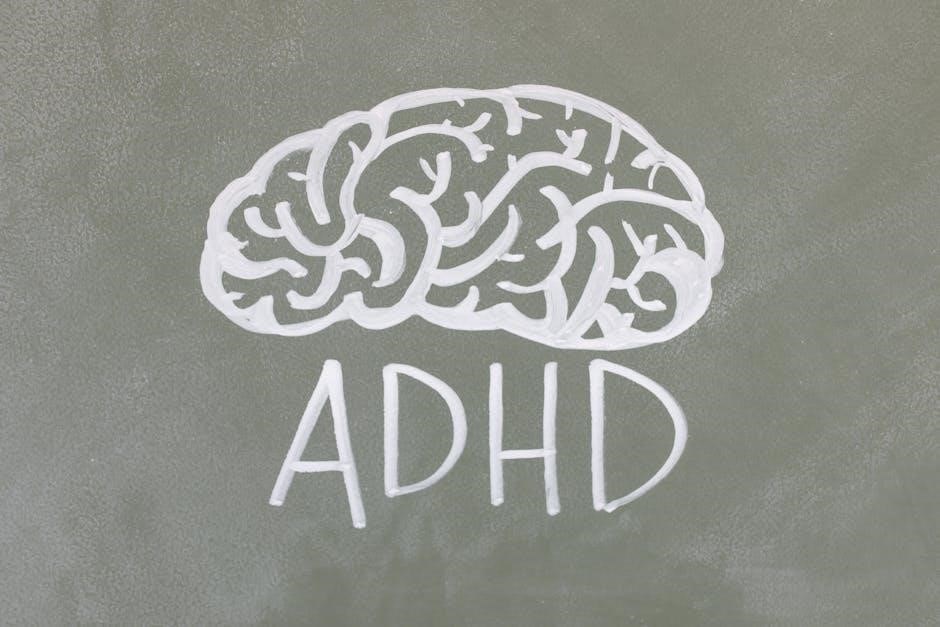
Dialectical Behavior Therapy (DBT) is an evidence-based psychotherapy developed by Dr. Marsha Linehan, focusing on teaching skills to manage emotions, tolerate distress, and improve relationships.
1.1 Overview of DBT and Its Importance
Dialectical Behavior Therapy (DBT) is an evidence-based approach developed by Dr. Marsha Linehan to help individuals manage intense emotions and harmful behaviors. It combines acceptance strategies with change-oriented techniques, focusing on four key skills: mindfulness, distress tolerance, emotion regulation, and interpersonal effectiveness. DBT is particularly effective for treating borderline personality disorder, anxiety, and other mental health issues. Its structured, skills-based approach makes it highly adaptable, empowering individuals to achieve emotional stability and improve their quality of life through practical exercises and strategies.
1.2 Brief History and Development of DBT
Dialectical Behavior Therapy (DBT) was developed in the 1980s by Dr. Marsha Linehan to address the unique challenges of treating individuals with borderline personality disorder (BPD). Combining principles from cognitive-behavioral therapy (CBT) with concepts of acceptance and mindfulness, DBT emphasizes the balance between changing harmful behaviors and accepting emotions. Over time, its application has expanded to treat various mental health issues, including anxiety, depression, and post-traumatic stress disorder (PTSD). The development of DBT workbooks has further enhanced accessibility, providing structured tools for skill-building and emotional regulation.

Key Components of DBT
Dialectical Behavior Therapy (DBT) emphasizes the balance between acceptance and change. It teaches four core skills: mindfulness, distress tolerance, emotion regulation, and interpersonal effectiveness.
2.1 The Four Main Skills of DBT: Mindfulness, Distress Tolerance, Emotion Regulation, and Interpersonal Effectiveness
Mindfulness teaches present-moment awareness without judgment. Distress tolerance helps manage crises without worsening situations. Emotion regulation targets reducing emotional intensity. Interpersonal effectiveness enhances communication while maintaining self-respect. These skills, outlined in workbooks, empower individuals to navigate emotions and relationships more effectively, fostering balance and resilience in daily life. Practical exercises in workbooks make these concepts accessible for self-practice and therapeutic settings.
2.2 The Role of Dialectics in DBT
Dialectics in DBT emphasize balancing opposites, such as acceptance and change. This central philosophy helps individuals reconcile contradictions, fostering a holistic approach to emotional and behavioral challenges. By integrating seemingly conflicting strategies, DBT encourages flexibility and adaptability. Workbooks often highlight dialectical thinking as a cornerstone of DBT, providing exercises to cultivate this mindset. This balance promotes personal growth, resilience, and effective coping strategies, making dialectics indispensable in the therapeutic process.

The Structure of a DBT Workbook
A DBT workbook typically includes sections on mindfulness, distress tolerance, emotion regulation, and interpersonal effectiveness. Practical exercises and worksheets guide users through skill development and self-reflection.
3.1 Typical Sections and Exercises Found in a DBT Workbook
A DBT workbook often includes sections dedicated to mindfulness, distress tolerance, emotion regulation, and interpersonal effectiveness. Exercises may involve journaling, skill drills, and real-life application tasks. Worksheets guide users in identifying and managing emotions, practicing acceptance, and improving communication. Practical activities help reinforce DBT techniques, such as creating a crisis survival kit or role-playing interpersonal scenarios. These tools encourage self-reflection, skill mastery, and gradual integration of DBT principles into daily life, fostering emotional resilience and personal growth.
3.2 The Importance of Practical Exercises and Worksheets
Practical exercises and worksheets in a DBT workbook are essential for applying skills to real-life situations. They provide structured tools for practicing mindfulness, distress tolerance, and emotion regulation, making abstract concepts actionable. Hands-on activities, such as journaling or creating a crisis survival kit, encourage personal reflection and skill mastery. Worksheets also help users track progress, identify patterns, and develop self-awareness. These resources bridge the gap between theory and practice, empowering individuals to integrate DBT techniques into their daily lives effectively.

Benefits of Using a DBT Workbook
A DBT workbook enhances emotional regulation and coping skills, teaching practical techniques for managing emotions, improving relationships, and reducing distress through structured exercises and real-life applications.
4.1 Improved Emotional Regulation and Coping Skills
A DBT workbook helps users develop emotional regulation by teaching mindfulness, distress tolerance, and emotion regulation skills. These exercises enable individuals to identify and manage emotional triggers, reducing intense feelings and impulsive behaviors. Practical worksheets guide users in practicing these skills, fostering self-awareness and resilience. By learning to balance acceptance and change, individuals can navigate emotional challenges more effectively, leading to improved mental stability and overall well-being. Regular practice enhances coping strategies, empowering users to handle life’s difficulties with greater ease and confidence, as outlined in various DBT resources.
4.2 Enhanced Interpersonal and Communication Skills
DBT workbooks emphasize interpersonal effectiveness, teaching users to communicate assertively and maintain healthy relationships. Through structured exercises, individuals learn to set boundaries, express needs clearly, and balance self-respect with empathy for others. These skills reduce conflicts and enhance emotional connections. Practical worksheets guide users in navigating difficult conversations and understanding others’ perspectives. By mastering these techniques, individuals can build stronger, more fulfilling relationships and improve their overall social interactions, fostering a sense of connection and mutual understanding in daily life. This enhances interpersonal dynamics and communication clarity, as highlighted in various DBT resources.

How to Choose the Right DBT Workbook
When selecting a DBT workbook, consider your target audience, evidence-based skills, practical exercises, and reviews. Look for awards like the Self-Help Seal of Merit for quality assurance.
5.1 Factors to Consider When Selecting a Workbook
When choosing a DBT workbook, consider your specific needs, such as managing anxiety or improving emotional regulation. Look for evidence-based skills like mindfulness, distress tolerance, and interpersonal effectiveness. Ensure the workbook includes practical exercises and worksheets to apply DBT techniques. Check for reviews and recommendations, as well as awards like the Self-Help Seal of Merit. Consider the target audience—some workbooks are tailored for adolescents or specific mental health challenges. Additionally, evaluate the workbook’s accessibility, such as digital formats or interactive features, to enhance your learning experience.
5.2 Reviews and Recommendations for Popular DBT Workbooks
Popular DBT workbooks, such as The Dialectical Behavior Therapy Skills Workbook by Jeffrey C. Wood, are highly recommended for their practical, step-by-step exercises. These workbooks are praised for their clear structure and focus on key DBT skills like mindfulness and emotion regulation. Many users appreciate the inclusion of downloadable PDFs and interactive features, making them accessible and user-friendly. Reviews highlight their effectiveness in helping individuals manage emotional distress and improve interpersonal skills. These resources are often endorsed by mental health professionals and are ideal for both self-help and therapeutic settings.

Using the DBT Workbook Effectively
Effectively using a DBT workbook involves consistent practice and applying skills to everyday situations. Setting clear goals and tracking progress helps maintain focus and motivation, while incorporating mindfulness and distress tolerance techniques fosters emotional resilience. Regular reflection and seeking support from professionals or groups enhances the learning process, ensuring long-term behavioral change and emotional well-being. Adapting strategies to fit personal needs is crucial for maximizing benefits and achieving lasting results.
6.1 Setting Goals and Tracking Progress
Setting clear, achievable goals is essential when using a DBT workbook. Identify specific skills you want to develop, such as mindfulness or emotion regulation. Track progress through journaling or worksheets, celebrating small victories to stay motivated. Regularly review and adjust goals to align with personal growth. Consistency and self-compassion are key to fostering long-term change and emotional resilience. By monitoring progress, you can identify areas needing improvement and refine your strategies for better outcomes, enhancing overall well-being and skill mastery.
6.2 Incorporating DBT Skills into Daily Life
Incorporating DBT skills into daily life involves consistent practice and mindful application of techniques like mindfulness, distress tolerance, and emotion regulation. Start by identifying triggers and applying relevant skills, such as deep breathing or grounding exercises, to manage emotions in real-time. Use worksheets from your DBT workbook to plan strategies for challenging situations. Over time, these practices become second nature, enhancing emotional resilience and improving relationships. Regular reflection and self-compassion are key to sustaining progress and integrating DBT principles into everyday routines effectively.

Supplementary Resources for DBT Learning
Supplement your DBT workbook with online courses, mobile apps, and free PDF resources offering practical exercises and tutorials to enhance your learning experience and skill mastery.
7.1 Online Courses and Tutorials
Online courses and tutorials provide structured learning opportunities to deepen understanding of DBT principles and skills. These resources often include video lessons, interactive exercises, and downloadable materials. Many courses focus on mindfulness, emotion regulation, and distress tolerance, aligning with the content of DBT workbooks. Platforms like Coursera and Udemy offer affordable options, while specialized websites cater to specific needs, such as anxiety or interpersonal effectiveness. Tutorials may also cover advanced techniques for applying DBT in daily life, making them a valuable supplement to workbook exercises.
7.2 Mobile Apps for DBT Practice
Mobile apps designed for DBT practice offer convenient tools to learn and apply skills like mindfulness, emotion regulation, and distress tolerance. Apps such as DBT Skills Coach and DBT Diary provide guided exercises, tracking features, and reminders to practice skills daily. These apps often include interactive modules, mood trackers, and customizable coping strategies. They serve as portable companions, enabling users to access DBT techniques anytime, anywhere, making them an excellent supplement to traditional workbooks and therapy sessions.

Common Mistakes to Avoid When Using a DBT Workbook
Common mistakes include inconsistent practice, misapplying techniques, and setting unrealistic expectations. Staying committed and seeking guidance can help avoid these pitfalls and enhance progress.
8.1 Lack of Consistency in Practice
Consistency is key to benefiting from a DBT workbook. Irregular practice can hinder progress, as skills require regular reinforcement to become effective. Without steady effort, emotional regulation and distress tolerance may not improve. Setting realistic goals and schedules helps maintain commitment. Overlooking even small practices can lead to stagnation. Remember, DBT skills are like muscles that need regular exercise to grow strong. Stay dedicated, and watch your ability to manage emotions and relationships transform over time.
8.2 Misapplication of DBT Techniques
Misapplying DBT techniques can undermine their effectiveness and even worsen emotional distress. For instance, using distress tolerance skills as avoidance strategies rather than temporary coping mechanisms can prevent meaningful progress. Similarly, misinterpreting dialectics may lead to confusion between acceptance and change. Incorrectly applying interpersonal effectiveness skills can strain relationships. It’s crucial to understand and practice DBT skills correctly, often with guidance from a therapist, to ensure they are used appropriately and effectively for emotional and relational growth.

Success Stories and Testimonials
Many individuals share powerful testimonials about how DBT workbooks have transformed their lives, improving emotional regulation and interpersonal skills, leading to lasting positive change and personal growth.
9.1 Personal Experiences with DBT Workbooks
Individuals often describe DBT workbooks as life-changing tools, providing practical exercises that help them manage intense emotions and improve relationships. Many users appreciate the structured approach, which allows them to track progress and apply skills in daily life. The workbooks’ accessibility and focus on self-compassion have empowered users to take control of their mental health journey, leading to significant improvements in emotional resilience and overall well-being.
9.2 How DBT Has Helped Individuals Manage Emotional Distress
DBT workbooks have proven instrumental in helping individuals manage emotional distress by teaching mindfulness, distress tolerance, and emotion regulation. These tools enable users to recognize emotional triggers and respond constructively, reducing overwhelm. Many report improved relationships and reduced anxiety, as they learn to balance acceptance with change. The structured exercises in workbooks provide a clear path to skill mastery, fostering long-term emotional resilience and stability. This practical approach has made DBT accessible and effective for many seeking to manage emotional challenges effectively.

The Future of DBT Workbooks
The future of DBT workbooks looks promising, with advancements in interactive digital formats and increased accessibility, ensuring continued growth in helping individuals manage emotional and psychological challenges effectively.
10.1 Emerging Trends in Digital and Interactive Workbooks
Emerging trends in DBT workbooks include the rise of digital and interactive formats, offering enhanced accessibility and engagement. Many workbooks are now available as downloadable PDFs, allowing users to access materials anytime, anywhere. Mobile apps and online platforms are also integrating DBT skills, making practice more convenient. Interactive exercises, multimedia elements, and personalized tracking features are becoming common, catering to diverse learning styles. These advancements ensure DBT resources remain relevant and effective in a tech-driven world, helping individuals manage emotional distress more efficiently.
10.2 The Role of Technology in Enhancing DBT Learning
Technology significantly enhances DBT learning by providing accessible tools for skill development. PDF workbooks and mobile apps offer convenience, enabling users to practice mindfulness, distress tolerance, and emotion regulation exercises anytime. Interactive platforms and online tutorials allow for personalized learning experiences, while progress-tracking features help users monitor their growth. Additionally, digital resources support self-therapy and remote therapeutic settings, making DBT skills more attainable for individuals worldwide. This integration of technology ensures that DBT remains adaptable and effective in addressing modern mental health challenges.
A DBT workbook PDF is a valuable resource for mastering dialectical behavior therapy skills, offering practical exercises to enhance emotional regulation and interpersonal effectiveness for lasting mental well-being.
11.1 Summary of Key Points
A DBT workbook PDF is a comprehensive tool for learning dialectical behavior therapy skills, focusing on mindfulness, distress tolerance, emotion regulation, and interpersonal effectiveness. These workbooks provide structured exercises and practical strategies to manage emotions and improve relationships. They are ideal for individuals, therapists, and groups, offering a flexible approach to skill development. By incorporating DBT techniques, users can track progress and enhance mental well-being. Overall, DBT workbooks are invaluable resources for anyone seeking to cultivate emotional resilience and personal growth through evidence-based methods.
11.2 Final Thoughts on the Value of DBT Workbooks
DBT workbooks are invaluable resources for individuals seeking to manage emotions, improve relationships, and enhance overall mental well-being. By providing practical exercises and structured guidance, they empower users to develop essential life skills. Their accessibility and flexibility make them suitable for self-help, therapy, or group settings. Whether addressing anxiety, emotional distress, or interpersonal challenges, DBT workbooks offer a powerful tool for personal growth and resilience, making them an essential companion for anyone embracing dialectical behavior therapy.




